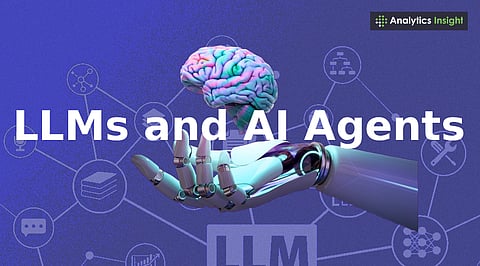

LLMs excel at understanding and generating human-like text for multiple tasks.
AI agents make decisions, take actions, and adapt to changing environments.
Combining LLMs with AI agents creates smarter, more capable autonomous systems.
Large Language Models (LLMs) and AI agents are the most recent advancements in the field of artificial intelligence. While some people assume these systems are quite similar and use them interchangeably under the term ‘AI,’ both function differently.
LLMs focus on understanding and creating human-like text, while AI agents carry out tasks, make decisions, and interact with their surroundings. Knowing what they are capable of provides a clearer understanding of how each can help solve problems in everyday life.
Large Language Models are AI systems trained on huge amounts of text to understand and create human language. Some examples are OpenAI's GPT series and Google's PaLM. These models are used to generate text, translate languages, summarize information, and answer questions. They work by predicting the next word in a sentence, which helps them create text that makes sense based on the input they get.
LLMs simply respond to prompts from users and cannot act on their own or make decisions independently. They are decent at handling language, which makes them useful for tasks that need understanding and generating text. Chatbots, content writing tools, and language translation apps use LLMs because they can generate text that seems like it was written by a human.
Also Read: LLMs vs SLMs: What’s the Difference Between Language Models?
AI agents are autonomous AI, which means they can perform tasks on their own when situations are complex and changing at a rapid pace. An AI agent usually has these abilities:
Perception: Understanding the environment.
Reasoning: Processing information and making decisions.
Action: Doing tasks based on decisions.
Learning: Getting better over time through previous experience.
AI agents can interact with their surroundings, make choices, and take action to reach goals. Unlike LLMs, they can start tasks on their own and respond to changes without waiting for humans. They are used in situations where decisions need to be made and actions need to be taken in real time.
Also Read: How Agentic AI Could Transform SEO Strategies in 2025?
LLMs are used in chatbots, writing tools, and translation services where understanding and generating text is the focus. They are useful when human-like language is needed, but no real actions are required.
AI agents are used in self-driving cars, robots, and smart assistants. These agents can manage schedules, check system performance, and even study data or run code without help. They are designed to work on their own and actively take steps to reach a goal.
Recently, LLMs have been added to AI agents, making them more powerful. With LLMs, AI agents can understand and produce text, making them easier to use. This lets AI agents perform tasks from understanding questions to completing difficult processes.
Microsoft’s 365 Copilot is one of the best examples of using AI agents with LLMs to help write emails, plan meetings, and manage projects. These agents also learn from interactions and get better.
LLMs and AI agents are both important in artificial intelligence, but they are used for different purposes. LLMs are utilized for tasks that involve understanding and generating human language. Whereas AI agents are used in workflows where taking action and making decisions to complete complex tasks is necessary.
Knowing the difference helps with using each technology properly. From simple text tasks to advanced autonomous systems, understanding their roles can make AI more useful. Combining LLMs and AI agents can create smarter systems that can do more on their own in many areas, making technology easier to work with and more capable in the real world.
1. What is the main function of Large Language Models (LLMs)?
LLMs understand and generate human-like text, answer questions, translate languages, and summarize information.
2. How do AI agents differ from LLMs?
AI agents can act autonomously, make decisions, interact with environments, and adapt to changing situations.
3. Can LLMs perform tasks on their own?
No, LLMs respond to prompts but cannot take independent actions or make decisions without guidance.
4. Where are AI agents commonly used?
They are used in self-driving cars, robots, smart assistants, and systems needing real-time decision-making.
5. What happens when LLMs are combined with AI agents?
Combining them allows AI agents to understand text, complete tasks, and improve efficiency through learning.
